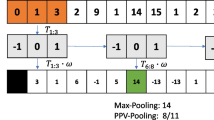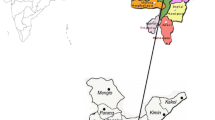Abstract
Time series prediction is a complex problem that consists of forecasting the future behavior of a set of data with the only information of the previous data. The main problem is the fact that most of the time series that represent real phenomena include local behaviors that cannot be modelled by global approaches. This work presents a new procedure able to find predictable local behaviors, and thus, attaining a better level of total prediction. This new method is based on a division of the input space into Voronoi regions by means of Evolution Strategies. Our method has been tested using different time series domains. One of them that represents the water demand in a water tank, through a long period of time. The other two domains are well known examples of chaotic time series (Mackey-Glass) and natural phenomenon time series (Sunspot). Results prove that, in most of cases, the proposed algorithm obtain better results than other algorithms commonly used.
Similar content being viewed by others
References
Bäck T, Hoffmeister F, Schwefel H-P (1991) A survey of evolution strategies. In: ICGA, pp 2–9
Bäck T, Schwefel H-P (1992) Evolutionary algorithms: Some very old strategies for optimization and adaptation. In: Proc. second int’l workshop software engineering, artificial intelligence, and expert systems for high energy and nuclear physics, pp 247–254
Booker LB, Goldberg DE, Holland JH (1989) Classifier systems and genetic algorithms. Artif Intell 40(1–3):235–282
Box GEP, Jenkins GM, Reinsel GC (1976) Time series analysis: forecasting and control. Holden-Day, Oakland
Fernández F, Isasi P (2008) Local feature weighting in nearest prototype classification. IEEE Trans Neural Netw 19(1):40–53
Fogel DB (1994) An introduction to simulated evolutionary optimization. IEEE Trans Neural Netw 5(1):3–14
Galván IM, Isasi P (2001) Multi-step learning rule for recurrent neural models: An application to time series forecasting. Neural Process Lett 13(2):115–133
Galván IM, Isasi P, Aler R, Valls JM (2001) A selective learning method to improve the generalization of multilayer feedforward neural networks. Int J Neural Syst 11(2):167–177
Holland JH (1975) Adaptation in natural and artificial systems. MIT Press, Cambridge
Lloyd SP (1982) Least square quantization in pcm. IEEE Trans Inf Theory 2(28):129–137
Luque C, Isasi P, Hernández J (2004) Distribución de cargas en una esfera mediante estrategias evolutivas. Rev IEEE Am Lat 2(2)
Luque C, Isasi P, Hernández JC (2004) Forecasting time series by means of evolutionary algorithms. In: PPSN, pp 1061–1070
Mackey M, Glass L (1977) Oscillation and chaos in physiological control systems. Science 197:287–289
Macqueen J (1967) Some methods for classification and analysis of multivariate observations. In: 5th Berkeley symposium on mathematical statistics and probability, Berkeley, January 1967
Meyer TP, Packard NH (1992) Local forecasting of high dimensional chaotic dynamics
Mitchell M (1996) An introduction to genetic algorithms. MIT Press, Cambridge
Moody J, Darken C (1989) Fast learning in networks of locally tuned processing units. Neural Comput 1:281–294
Packard NH (1990) A genetic learning algorithm for the analysis of complex data. Complex Syst 4(5):543–572
Papalexopoulos A, Hesterberg T (1990) A regression-based approach to short-term system load forecasting. IEEE Trans Power Syst 5(4):1535–1547
Park D, El-Sharkawi M, Marks I, Atlas L, Damborg M (1991) Electric load forecasting using an artificial neural network. IEEE Trans Power Syst 6(2):442–449
Platt J (1991) A resource-allocating network for function interpolation. Neural Comput 3:213–225
Quintana D, Luque C, Isasi P (2005) Evolutionary rule-based system for IPO underpricing prediction. In: Proceedings of genetic and evolutionary computation conference (GECCO 2005), pp 983–989
Rahman S, Hazim O (1993) A generalized knowledge-based short-term load-forecasting technique. IEEE Trans Power Syst 8(2):508–514
Schwefel HP (1965) Kybernetische Evolution als Strategie der exprimentellen Forschung in er Strömungstechnik. PhD thesis
Somervuo P, Kohonen T (1999) Self-organizing maps and learning vector quantization for feature sequences. Neural Process Lett 10(2):151–159
Valls JM, Galván IM, Isasi P (2008) Learning radial basis neural networks in a lazy way: a comparative study. Neurocomputing 71:2529–2537
Wei H, Billings S (2006) An efficient nonlinear cardinal b-spline model for high tide forecasts at the Venice lagoon
Yingwei L, Sundararajan N, Saratchandran P (1997) A sequential learning scheme for function approximation using minimal radial basis function neural networks. Neural Comput 9:461–478
Zaldivar J, Gutiérrez E, Galván I, Strozzi F, Tomasin A (2000) Forecasting high waters at Venice Lagoon using chaotic time series analysis and nonlinear neural networks. J Hydroinf 2:61–84
Zuo J, Tang C, Li C, an Yuan C, long Chen A (2004) Time series prediction based on gene expression programming. In: Li Q, Wang G, Feng L (eds.) Advances in web-age information management: 5th international conference, WAIM 2004, Lecture notes in computer science, vol 3129, pp 55–64, Dalian, China, 15–17 July 2004. Springer, Berlin
Author information
Authors and Affiliations
Corresponding author
Rights and permissions
About this article
Cite this article
Luque, C., Valls, J.M. & Isasi, P. Time series prediction evolving Voronoi regions. Appl Intell 34, 116–126 (2011). https://doi.org/10.1007/s10489-009-0184-9
Received:
Accepted:
Published:
Issue Date:
DOI: https://doi.org/10.1007/s10489-009-0184-9




